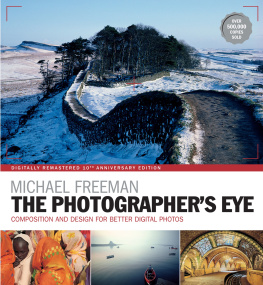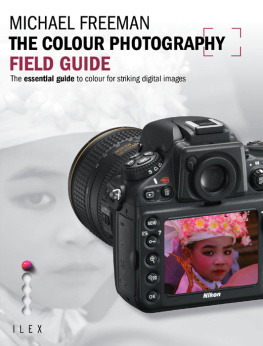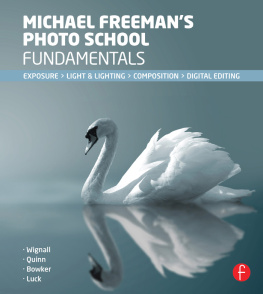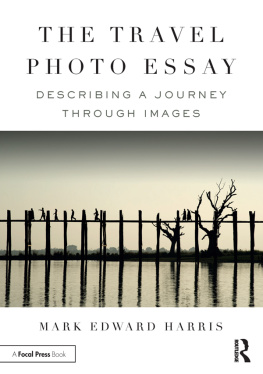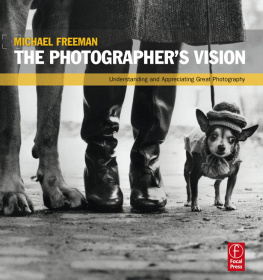BIBLIOGRAPHY
Arnheim, Rudolf. Art and Visual Perception. Berkeley, Los Angeles, London: University of California Press; 1954.
Berger, John. About Looking. London: Writers & Readers; 1980.
Berger, John. Ways of Seeing. London: BBC/Penguin; 1972.
Bouleau, Jacques. The Painters Secret Geometry. New York: Hacker Art Books; 1980.
Cartier-Bresson, Henri. The Minds Eye. New York: Aperture; 1982.
Dexter, Emma. Weski, Thomas. Cruel and Tender. London: Tate Publishing; 2003.
Eauclaire, Sally. The New Color Photography. New York: Abbeville Press; 1981.
Evans, Harold. Pictures on a Page. London: William Heinemann Ltd.; 1978.
Frank, Robert. Peru. Washington: Steidl / National Gallery of Art; 2008.
Freeman, Michael. The Photographers Eye. Lewes: Ilex; 2007.
Garner, Gretchen. Disappearing Witness: Change in Twentieth-Century American Photography. Baltimore and London: The Johns Hopkins University Press; 2003.
Gombrich, E.H. Art & Illusion: A Study in the Psychology of Pictorial Representation. London: Phaidon; 2002.
Gombrich, E.H. The Image and The Eye. Oxford: Phaidon; 1982.
Gregory, Richard L. Eye and Brain: The Psychology of Seeing. Oxford: Oxford University Press; 1998.
Haas, Ernst. In America. London: Thames and Hudson; 1975.
Haas, Ernst. The Creation. Harmondsworth: Penguin Books; 1971.
Jacobs, Karen. The Eyes Mind: Literary Modernism and Visual Culture. Ithaca and London: Cornell University Press; 2001.
Kerouac, Jack. The Americans. Washington: Steidl/National Gallery of Art; 2008.
Koestler, Arthur. The Act of Creation. London: Hutchinson & Co. Ltd.; 1964.
Livingstone, Margaret. Vision and Art: The Biology of Seeing. New York: Abrams; 2002.
Loran, Erle. Czannes Composition. Berkeley: University of California Press; 2006.
Irving Penn. Still Life. London: Thames & Hudson; 2001.
Rothenstein, John. The World of Camera. London: Thomas Nelson and Sons Ltd. 1964.
Shaw, Philip. The Sublime. London and New York: Routledge; 2006.
Smith, W. Eugene. The Camera as Conscience. London: Thames and Hudson; 1998.
Sontag, Susan. On Photography. New York: Farrar, Straus & Giroux. 1973.
Hiroshi Sugimoto: Time Exposed. London: Edition Hansjrg Mayer; 1995.
Szarkowski, John. Looking at Photographs. New York: The Museum of Modern Art; 1973.
WHAT A PHOTOGRAPH ISAND ISNT
TAKES DIRECTLY FROM REAL LIFE
Although the camera can be used to construct images, particularly in studio work, the great strength of photography is that the physical world around us provides the material. This elevates the importance of the subject, the event; and the reporting of this is obviously something at which photography excels. At the same time, however, this ease of capture reduces the value of accurate representation, because it has become commonplacevery different from the early view of painting, when Leonardo da Vinci wrote in his notebook that painting is most praiseworthy which is most like the thing represented. Instead, the way in which photographers documentthe style and treatmentbecomes more significant.
At a deeper level, there is an inherent paradox between depicting reality and yet being something completely apart as a free-standing image. Other arts, like painting, poetry, and music, are obvious as constructs. There is no confusion in anyones mind that a poem or a song have originated anywhere else but in the mind of their creator, and that the experience in life that they refer to has been filtered through an imagination, and that some time has been taken to do this. In this respect, photographs do create confusion. The image is, in most cases, so clearly of a real scene, object, or person, and yet it remains just an image that can be looked at quietly in completely divorced circumstances. It is of real life, and at the same time separate. This contradiction offers many possibilities for exploration, and much contemporary fine-art photography does just that, including making constructions to mimic real-life content.
FAST AND EASY
Photography can explore and capture all aspects of lifeand increasingly so as the equipment improves. One example of this is the increased light sensitivity of sensors, which has made night and low-light imagery possible. We take this pretty much for granted, but it is a strong driving force behind photographys immense popularity. Little or no preparation is needed to capture an image, which means that there are many, many opportunities for creative expression. As digital cameras make this easier and more certain technically, it also focuses more and more attention on the composition and on each persons particular vision. Or at least it should, provided we dont get sidetracked by the bright, shiny toy component in photography. Photography is the easiest art, wrote photographer Lisette Model, which perhaps makes it the hardest. There is unquestionably less craftsmanship in photography in the sense of time and physical effort than there is in other visual arts, something many professionals feel defensive about. But in its place, the act of creation is extended afterwards to reviewing and selecting already-taken images. As well as editing, as this is called, the processing and printing of images is also a later and important part of the process.
CAN BE TAKEN BY ANYONE
This never happened in art before. Photography is now practiced nearly universally, and not just to record family moments, either. Its no longer a case of artists and professionals on one side, audience on the other. Digital cameras, sharing across the internet, and the decline of traditional print media have made photography available to almost everyone as a means of creative expression. Nor do these many millions of photographers feel bound by the opinions of a few. Many are perfectly happy with the opinions of their peers, as audience and photographers are usually the same people. All of this makes contemporary photography wide-ranging and complex, with different and competing standards and values. Creating good photographs does not depend on a career plan, which for all save professionals is good news. What is less good is that a large number of images tends to confuse any judgement of excellence, and the internet is awash with imagery.

Humanism in China: A Contemporary Record of Photography Xie Haitao/FOTOE/www.fotoe.com/image/10126149
Scene of a building collapse, Xian, Shanxi, 2000, by Xie Haitao
This is a tough first picture for the book, but it illustrates in an uncompromising way what photography does that no other art can (video excepting). It can report exactly what was in front of the camera in that place on that day in history, and at that moment. We may not always like what we see, but that is the nature of the special contract between the photographer and the viewer. Unretouched images that are captured from life were the original form of photography, and many would argue that this is its most legitimate form.
HAS A SPECIFIC LOOK
Whatever choice of paper texture and coating you make for a print, the image itself is completely without a third dimension. The frame is a window, and this sets photography apart from painting and from any kind of imagery created by hand. In many ways, this lack of physical presence makes screen display perfect, and this is increasingly how most photographs get viewed.
In terms of its look, photography begins with the viewers expectation that the contents are realtaken from real life. In fact, we relate the appearance of a photograph to two things: how we ourselves see, and how we have learned to accept the look of a photograph. We are very sensitive to the naturalism and realism of a photograph. The further that a photographer takes the image away from this, by complicated processing or unusual post-production techniques, the less the image is photographic. This is not a criticism, just a statement of obvious fact. The basic photographic look relies on the assumption that very little has been done to the image since it was captured. Photography also has its own vocabulary of imagery, not found anywhere else. This includes such things as differential focus, a limited dynamic range, motion blur, flare artefacts, less-than-fully-saturated colors, and the possibility of rendering the image entirely in black and white.



